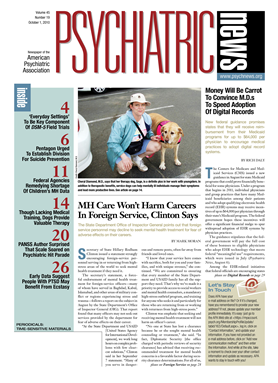Could harried urban lives in which strangers' unusual or disruptive behaviors are widely ignored have the practical effect of leaving many people with serious mental illness untreated? Conversely, could the slower pace and closer connections in rural areas make the strange behavior of people with untreated psychoses stand out and result in more offers of mental health interventions?
Both situations are possible based on recent research that showed broad associations between urban living and higher rates of nonaffective psychosis. Specifically, a study published in the September Archives of General Psychiatry indicated that the greater amounts of social fragmentation and individual isolation found in urban areas increased the risk of developing a psychotic disorder.
Stanley Zammit, Ph.D., of the Department of Psychological Medicine and Neurology of the School of Medicine at Cardiff University in Wales, and his colleagues noted that their study's findings highlight a concern that physical integration of minority ethnic groups in particular into the larger community is not enough to prevent the isolation of individuals that is linked to development of serious mental illness. The researchers concluded that a localized perception of safety, cohesion, and community spirit should also be encouraged among people who are the minority in their cities to draw them into the life of the broader population.
The new study was designed to identify the reasons behind previous research findings that there is an increased incidence of schizophrenia and other nonaffective psychoses in urban locales over that found in rural areas.
The multilevel study examined national health data for all individuals born in Sweden in 1972 and 1977—203,829 people—as well as their demographic, educational, and geographic information. The authors tried to identify links between urban living and serious mental illness among the 881 people in the two cohorts who were diagnosed at some point with nonaffective psychosis, including schizophrenia.
Their findings reinforced previous research demonstrating that growing up in urbanized areas was associated with an increased risk of developing any nonaffective psychotic disorder. Additionally, Zammit and colleagues found that geographic association was primarily explained by the social characteristics of the geographic area rather than by individual characteristics of the people. Among the geographic characteristics that had a major association with a person's risk for developing a psychosis was “social fragmentation,” or the lack of participation in the social life of his or her community.
Although previous studies have uncovered similar findings, the unique approach of tracing the lifetime influences affecting an entire population group allowed the researchers to ensure that the link between geographic location and psychosis was not due to individuals' changing their locations after the onset of their illness by moving to urban areas from less-populated ones.
The researchers found that social fragmentation especially affects population subgroups that previous studies have found to suffer from higher rates of psychosis: migrants and people who are ethnic minorities in the areas in which they lived. The impact of ethnic minority status became even greater when the minority's size lessened as a proportion of the local population.
The findings led the authors to conclude that social policy should be adjusted to minimize the risks associated with social isolation by not only encouraging the integration of individuals within communities but also promoting the development of socially and ethnically mixed communities in general.
